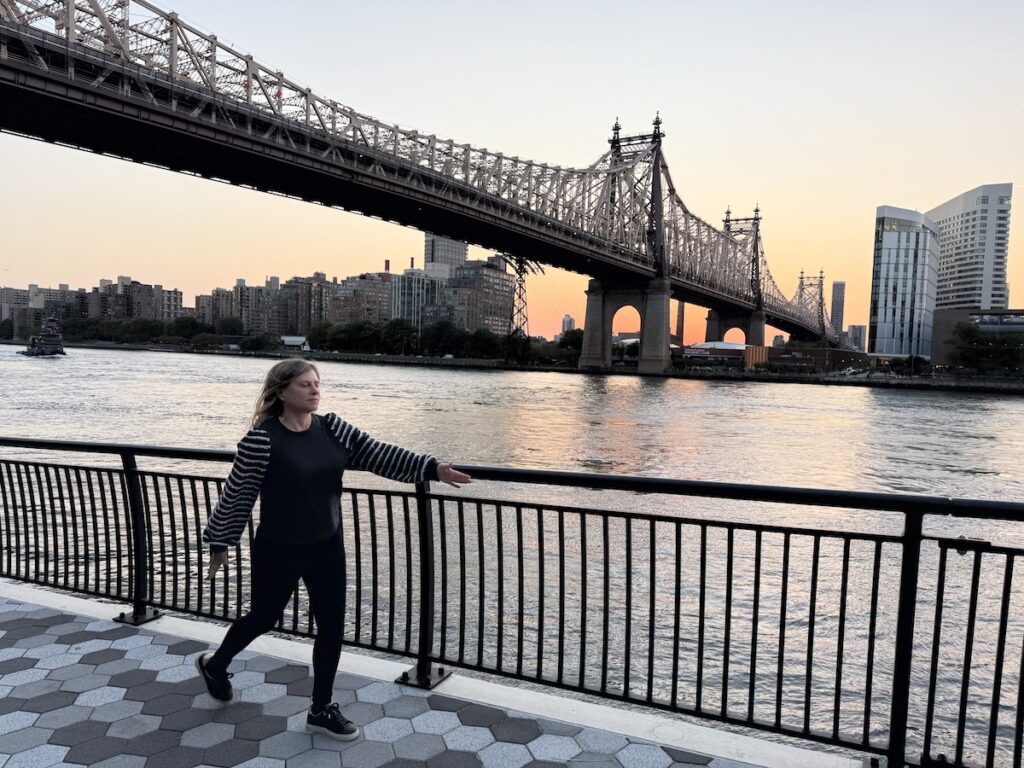5 Alternatives to Sit Down Meditation
Meditation is not limited to formally sitting with your eyes closed. It is about being awake and aware no matter where you are. So, whether you are sitting, lying down, walking, standing, washing the dishes, taking a shower, biking, fishing, swimming, cooking, etc., each moment presents an opportunity to re-arrive. I want to introduce you to a variety of alternatives to traditional “sitting” meditation because the beautiful thing about meditation is that it can take place anytime and anywhere!
Let’s explore how you can incorporate walking, silent , mindful eating, standing, and mindful movement meditation into your daily life!
Walking Meditation
Walking meditation is especially helpful when your mind is scattered or you’re finding it difficult to be present. It can help you stay calm and cultivate absorption and concentration so you can bring your attention to the present. When you are mindful of the sensations of the present, all the senses may wake up.
In classical walking meditation, it is helpful to move your body by swaying a bit from side to side and bring your proprioception into the feet. To feel the pressure, feel the bones in the feet, get the connectedness with the Earth. Your arms can either be down by your side, or you can clasp your hands in front or behind. It can be helpful to have your eyes gaze downward to help you contain your attention. One of the elements of walking meditation is the option to label the movement of your feet as it is happening. Classically, it can be broken down in three parts – lifting, moving and then placing. The next thing to consider is speed. Start at a pace that feels natural; when you go slow, you may notice more, but if you go too slow, you may get wobbly.
You can explore this type of moving meditation anytime, such as walking from the store to the car or from your desk to the bathroom. Being outside is a wonderful place to practice walking meditation, whether you are walking in the woods, or down the street. How awake can you be in the senses? You can pause and take it all in. You can get all senses involved—the kinesthetic—the feeling inside as you are moving—the visual—the smell—the sounds—and sometimes the taste!

Silent Meditation
In the meditation world, silence isn’t always observed. How one meditates is largely dependent on what works best for you. Some people require vocal guidance to enter a meditative state, while others may engage in chanting. Meditation can even involve movement, and such is the case in a practice like yoga.
Silent meditation is any meditative practice in which the meditator observes silence from start to finish. This could be anything from a few minutes, or up to a period of 70 days during a silent retreat.
Starting each day with 5-10 minutes of silent meditation is one of the best things a person can add to their daily rituals/practices. I practice this daily; I do five minutes of meditation as the sun rises, and five minutes as it sets. This helps with the body’s Circadian rhythms—which can facilitate a good night’s sleep
Silent meditation can give you time to just sit with what’s going on in your mind., without the interference of sound. When we take time to meditate silently, we give ourselves the opportunity to refresh, reset, and reframe how we are showing up in the world around us.”

Mindful Eating Meditation
Today’s fast-paced society offers people an abundance of food choices. On top of that, distractions have shifted attention away from the actual act of eating toward televisions, computers, and smartphones. Eating has become a mindless act, often done quickly. This can be problematic since it takes time for your brain to register that you are full. If you eat too fast, the fullness signal may not arrive until you have already eaten too much. By eating mindfully, you restore your attention and slow down, making eating an intentional act instead of an automatic one, bringing more presence and appreciation. What’s more, by increasing your recognition of physical hunger and fullness cues, you can distinguish between emotional eating and true physical hunger (9Trusted Source) and increase your awareness of food-related triggers, giving you the freedom to choose your response to them.

Fundamentally, mindful eating is a form of meditation that involves:
- Eating slowly and without distraction
- Listening to physical hunger cues and eating only until you’re full
- Distinguishing between true hunger and non-hunger triggers for eating
- Engaging your senses by noticing colors, smells, sounds, textures, and flavors
- Learning to cope with guilt and anxiety about food
- Eating to maintain overall health and well-being
- Noticing the effects food has on your feelings and body
- Appreciating your food
Some tips to mindful eating:
Begin with your shopping list
Consider the health value of every item you add to your list and stick to it to avoid impulse buying when you’re shopping. Fill most of your cart in the produce section and avoid the center aisles—which are heavy with processed foods — and the chips and candy at the check-out counter.
Come to the table with an appetite — but not when ravenously hungry
If you skip meals, you may be so eager to get anything in your stomach that your priority is filling the void instead of enjoying your food.
Start with a small portion
It may be helpful to limit the size of your plate to nine inches or less.
Appreciate your food
Pause for a minute or two before you begin eating to contemplate everything and everyone it took to bring the meal to your table. Whether you cooked it, someone else did, or you ordered in, silently express your gratitude for the opportunity to enjoy delicious food and the companions you’re enjoying it with.
Bring all your senses to the meal
When you’re cooking, serving, and eating your food, be attentive to color, texture, aroma, and even the sounds different foods make as you prepare them. As you chew your food, try to identify all the ingredients, especially seasonings.
Chew thoroughly
Chew well until you can taste the essence of the food. (You may have to chew each mouthful 20 to 40 times, depending on the food.) You may be surprised at all the flavors that are released.
Eat slowly
Savor the experience.
Standing Meditation
Standing meditation can be a formal part of your mindfulness practice. At times, when you feel sleepy, or distracted, this form of meditating can help you feel more balanced.
Find a quiet, pleasant place to practice meditating. Initially, it’s best to practice this inside, though facing a window to see inspiring natural beauty is good. Stand with your feet hip-width apart and parallel (toes pointing straight forward). Soften the backs of your knees just enough to feel your pelvis relax downward, and feel the weight come into your feet. It should feel as though you just mounted a horse.
Gaze straight forward, with your head aligned right on top of your spine so the muscles of your face, head, neck, and throat can be relaxed. Smile gently and float the tip of your tongue up toward the roof of your mouth, just behind your upper front teeth. Your tongue can be touching your teeth or just hovering really close.
Now, float your hands up eight to ten inches in front of your lower abdomen, palms facing your lower dantian (a couple of inches below your navel), and the fingertips of your two hands pointing toward (but not touching) each other. You should be positioned almost as though you were hugging a small tree. Let your fingers be extended, with space between them, and your elbows slightly lifted so your armpits feel hollow.
Take a couple of deep inhales and complete exhalations. As you do this, make whatever small adjustments you need to your stance so that it feels comfortable. Imagine that you are a mountain or an ancient redwood — something profoundly stable and serene.
Now let your breath return to its natural rhythm and come to a place of stillness in your physical body. Focus your soft gaze gently in front of you while maintaining a light awareness of your dantian. Settle into doing nothing.
Hold this position for ten minutes or longer. Increase the amount of time over the weeks, months, or years that you practice.

Mindful Movement
Any form of movement, when done with attentiveness, can become a way to embody presence and mindfulness, regardless of what the movement is. It could be some contemplative movements of yoga and qigong. It can be dance. It can be walking meditation (as discussed above). These are all ways to embody presence. Our bodies are always speaking to us, we can neglect to listen to the language of the body. So by intentionally brining a keen awareness to that language while engaged in movement meditation, we return to presence and tap into a great reservoir of insight. Our breath is what breaths the body into life. When we bring attention to the body and pair it with the breath, we gain access to channels of energy that are many times blocked from inattentiveness, from neglect.
A great benefit of becoming aware of what is arising in the body is that the awareness brings us directly to the door of choice where we are no longer imprisoned by conditioned habits. Our bodies are gifted with varying degrees of capacities and capabilities When we attune to our own capabilities, free of judgement, comparison or a need to fix, we can then be open to new possibilities, potentialities, and access greater internal wisdom Regardless of what we encounter, when we are able to acknowledge and investigate with curiosity whatever arises within the body, when we are able to discern between what is arising from what our body is truly telling us, we enter into a realm of freedom, specious relaxation, and peace, because of the choices it offers us to have that awareness. So, I invite you to tap into the unique voice of your body and to listen intently to its needs, to meet yourself at your own capacity, and to marvel at the miracle of breath that nourishes and animates the body.

I encourage you to try each of these alternatives to traditional “sitting” meditation. Notice how moving and/or being silent affects your presence in the present moment. If you are struggling to awaken your mind, try a different form of meditation and see if it helps.
















